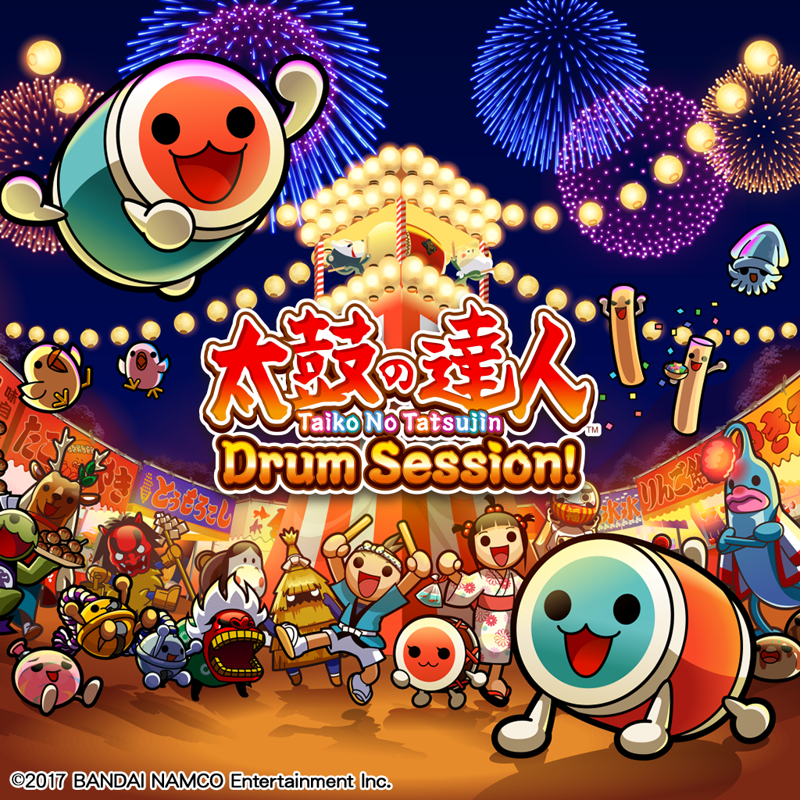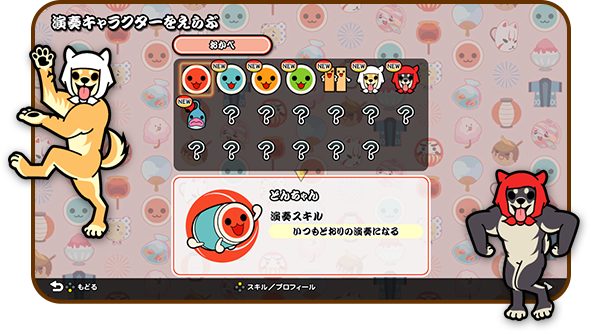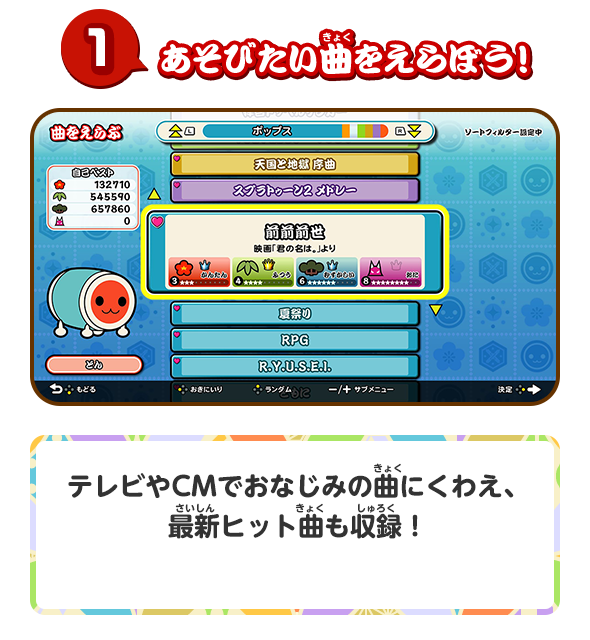Coming this far into our introductory guide to Taiko gaming, you've seen what the series' core is about, alongside a quick look at more technical-leaning content and some general tips for playing on both arcade and console games. Now you're probably set on getting your hands on a console Taiko game yourself, but then you might be questioning yourself... "Where do I start, anyway?"
This is a quite legittimate thought to have, as the Taiko no Tatsujin series can nover tens of different console games to this day, spanning across a lot of platforms along the years! In order to aid newcomer players to a more informed decision, this section will act as a sort of "comparison guideline" for you to ponder on, helping to figure out what's your best place to start moving your first steps into the series. With the Taiko no Tatsujin franchise becoming more known in the Western gaming scene with the official localization of two titles in 2018 -the PS4's Session de Dodon ga Don and the Switch's Nintendo Switch Version- we'll be using the two games to draw comparisons with our suggested model, for the sake of this section.
Please also keep in mind that the two games will have a slightly different title for their non-Asian releases (Drum Session! for the PS4 game and Drum 'n' Fun! for the Switch one), so you'll be able to see both names in our blog as a means for discussing them, while their related song list pages will display the original Japanese names instead.





While the arcade Taiko versions will only let you play with the cabinet's own Taiko drum peripherals, console Taiko titles often let players choose between three different input choices, visually summed up by the three pictures above and briefly described below:
-) Buttons - The controller/portable system's face buttons and the directional arrows are used to register the drum hits, with a simultaneous double-input of the same note type being required to clear big note markers for the best accuracy judgement. In some games, the shoulder-buttons can also be used to play alongside the main buttons, or another system-compatible controller can be used to play in place of the main one (ie. the Nintendo Wii/Wii U's Pro controllers). All titles, however, will allow the players to change the input settings on their respective Option menu by choosing one of the (up to 4) pre-registered controller set-ups to play.
All Taiko home/portable console games to date will allow the buttons control scheme, minus the smartphone games.
-) Taiko Controller - The game is played with a smaller Taiko drum peripheral, performing Don and Kat hits just like in the arcade counterpart: Don note hits on the center, Kat hits on the rims. Known over the years by the 'TaTaCon' name, the console Taiko peripheral can often be bought as part of a more expensive bundle with its related Taiko game, but standalone versions also do exist to be purchased separately. There are some variation between different systems' TaTaCon models, as they all have different ways to be connected to their respective gaming systems of choice (PS2 controller port, Wii Nunchuck port and USB port).
All home console games allow to play with their respective Taiko drum controller variant, with the smartphone game Taiko + also being compatible with a dedicated, wireless version.
-) Touch Screen - A Taiko drum is displayed on a different screen (or at one screen's lower side), and the players has to touch said screen accordingly in order to hit the notes, touching the face drum for Don notes and the screen border outside the drum for Kat notes. Big note hits are performed by single-touching the screen in certain hot spots: the center of the drum for big Don hits and the drum's rims for big Kat hits.
Taiko + and all the portable console games on touch screen systems can be played with the touch controls, as well as the Nintendo Wii U and Switch's games with their respective touch screen peripherals.
Pondering on which control style/s are preferred to play a console Taiko game before a purchase is a must, as one big hurdle for non-Asian players will remain the ordering/costs process; as the years come and go, older Taiko games and peripherals will have quite the high cost on average and even for getting a physical copy of a recent game, importing a game with its Taiko drum peripheral in advance will be a money-saving action most of the times, as the prices will have the tendency to ramp up. Bottom-line: figure out how much are you going to spend for a single Taiko-related purchase course of action, as opposed to buy multiple items in separate occasions over time.
This is a problem that also touches the localized versions of the PS4 and Nintendo Switch debut titles, as there are regional distribution differences between the North American and European games distribution. For clarity's sake, we'll profile it here as well:
Taiko no Tatsujin Drum Session! (PS4)
NA, EU - digital-only release, no Taiko drum peripheral
Taiko no Tatsujin Drum 'n' Fun! (NSwitch)
NA - digital-only release, no Taiko drum peripheral
EU - digital and physical release, Taiko drum peripheral available (TaTaCon + game bundle only)
Last but not least, be sure to check out if your Taiko purchase is for a videogame system that allows to play games from other regional areas. On console grounds, the only gaming system that have the region-free games support to this day are the Nintendo DS, the PSP, the PS Vita, the PS4 and the Nintendo Switch; if your Taiko purchase is for one of these systems, you'll be able to play them with any region variant of your gaming system of choice!
2) Signature Features


Every console game has one or more one or more distinguishable modes and/or features that slightly stray away from the core Taiko gameplay of the series, with some offering different way to drum up your fun and others adding some stylistic customization option just for eye-candy. In some games the two aspects do intertwine for some of those features! While the exclusive side content is not usually what keeps a core Taiko player to come back to play more of the game, these can also be taken in consideration while deciding your starting Taiko game. Do also keep in mind that some exclusive features are more geared towards either single-player or multi-player sessions.
There's not a "rule-of-thumb" sort of thing for Taiko console games to figure out signature content in advance, but selected returning trends may come back from time to time, according to either the chosen system or the portable/home console status; portable games, for example, are more inclined to feature a Story mode of sorts, but the first two Wii Taiko game do also have something to follow that trend (to an extent). Once again, what's important to understand for these is to see what kind of game experience you're mainly going to have (or imagining to have) between single-player and multi-player sessions as well as, of course, to see which signature feature set is more of your personal liking.
For what concerns our PS4/NSwitch scenario, for example, we can come out with a feature analysis like the following one, under these lines. Try to find more out of different games from the past as well, and see which one aligns with your personal preferences the most!
Taiko no Tatsujin Drum Session! (PS4)
-) Single-player-focused Score Attack modes (Guest Session, Ghost Session, point-attack events)
-) Training mode for all songs
-) Main mode multiplayer for up to 2 players
-) Taiko avatar customization options (up to 3 costume parts + a Petit Chara; customizable Taiko sound/body color choice)
Taiko no Tatsujin Drum 'n' Fun! (NSwitch)
-) Performance Character system for the main mode (single-player and multi-player)
-) Main mode multiplayer for up to 2 players on the same system (up to 4 with multiple Nintendo Switch systems)
-) Minigame mode for up to 4 players on the same system (20 minigames + harder variants)
-) Furifuri control scheme to play by swinging the JoyCon controllers in the air
3) The Song List


This is by far the most important indicator to factor in your Taiko game purchase, as playing a music game with a song selection of your greater liking is already more than half of the enjoyment to take out of any rhythm game in general.
The Taiko no Tatsujin series has always been really lenient to feature songs that are thematically different from each other, spanning from popular licensed picks to original tracks/arrangements from Bandai Namco talents and affiliated external artists; with that in mind, figuring out what is your best kind of song list formation can really make the difference! For this aspect, two are the main indicators you'd like to look after: what songs do you like the most (either specific songs or specific song genres in general) and what kind of general difficulty degree do you enjoy the most.
All Taiko games across the years might be able to have a variable number of representatives for each side to any people's liking, but it can be universally recognized how Taiko games for certain platforms have been compiled to be mainly enjoyed by different age groups; most of the Nintendo games tend to have many children-friendly tracks among the licenses, while the more modern games for Sony platforms do range to content aimed to a slightly-older audience bank.
No matter what console game you're gonna get, you can rest assured to see some popular tracks from Taiko lore again and again in console gaming, so it's really hard for newcomers not to come across a game with any of the most iconic songs from both the licensed bank and the original composition... Hey, if you pay attention to the PS4/NSwitch screen above, you can see how even current songs (for the time of the respective games' release) like Zen Zen Zense happen to be ported in more than one console game in a really short time span.
In the end, however, there's really one course of action for you to take on the song list matter: see it for yourself! Have a look at our blog's song list pages for the individual games and compare which track list has the most suiting tracks to your own personal taste. You can already jump on it by seeing for yourself the track lists for the PlayStation 4 and Nintendo Switch debut games, right here:
Session de Dodon ga Don/Drum Session! Song List (PS4)
Nintendo Switch Version/Drum 'n' Fun! Song List (NSwitch)
-----------------------------------------------------------------
As an afterword to the song list talk, it's a good custom to digress on the downloadable content situation, as the most recent console Taiko games have started to distribute additional download content.
Taiko games with DLCs are currently gating said additional content to the digital store outlets for the Asian-regions audience, with different-area localized versions of Taiko games being either devoid of any DLC from the original version or starring a smaller selection from the original version. Furthermore, if you want to enjoy the (currently-available) downloadable content for any of the Taiko games's original Japanese version, be prepared to open up a separate digital store profile for your Taiko console/s of choice's digital store, so that you can carry out with your preferred purchases.
Each of our blog's song list pages will mark down the available downloadable contents for each game, so if you are in the mood of purchasing a game with a JP digital store account on the go to nab some extra tracks or features, assess for yourself what additional perks are in store for the game/s you're looking at and decide if it's of your liking or not. If a game has some of its DLC content being ported to the eventual General Asia/Western releases, these will also be properly addressed in the related 'Additional Contents' page for each of the respective Taiko games.



